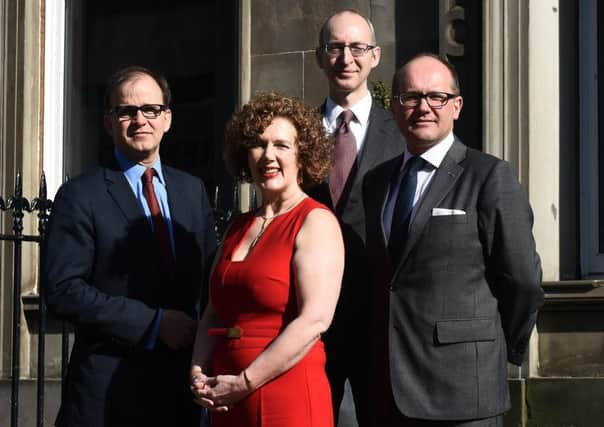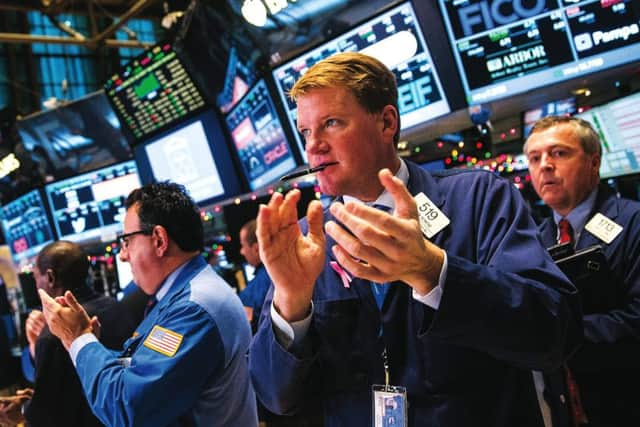The Scotsman's Market Conference: Individual instincts hold key to investing


Delegates at The Scotsman’s annual investment conference –Home or Overseas: Where to from here? – were reassured that there are excellent opportunities out there, but warned to take a cautious approach.
Caspar Rock, chief investment officer at Cazenove Capital, said investors had to be agile and ready to re-shape their portfolios quickly against a challenging global backdrop.
“Sentiment worries me,” Rock said.


Advertisement
Hide AdAdvertisement
Hide Ad“Many multi-asset commentators from Wall Street and the City of London are bullish on equity markets.
“There is a chorus of consensus. If everyone is bullish, take a more circumspect view.”
He described Cazenove’s business cycle investment approach, which advises an active allocation of assets depending on the stage of the business cycle – slowdown, recession, recovery or expansion.
Cazenove’s latest “cycle positioning” has the United States, Japan and the Eurozone in expansion mode, with the UK in slowdown.


“The UK has gone from being one of the best-performing economies between 2013 to 2016 to the worst-performing economy in the G7,” said Rock.
“It is over-leveraged, has weaker retail sales and its disposable income is not growing as fast as elsewhere.”
Despite some positive, but unexciting signs, Rock described the UK economy as “a reluctant participant in the global recovery” and said Brexit uncertainty had definitely affected confidence.
Rock said we should expect greater market volatility in this year and thought central banks across the world would follow the lead of the Federal Reserve in the US and reduce their balance sheets.
Advertisement
Hide AdAdvertisement
Hide AdHe was, however, optimistic about growth in the US and the prospects for US equities (as opposed to his gloomier outlook for UK equities), although he said the potential for US growth was offset by high valuations.
However, there were certainly pockets of value to be found, said Rock – and “cash is not a bad place to be”.
He concluded with a cautious message, saying that an increasingly leveraged global economy, shaky credit ratings and the growing number of zombie companies meant it was prudent for investors to remain fleet of foot and “dance nearer to the door”.
Russ Mould of AJ Bell also had a cautious message, quoting the Roman Stoic philosopher Seneca: “I don’t know what’s going to happen, but I do know what’s capable of happening – and none of this will give rise to protestation on my part. I’m ready for everything.”
The broad-ranging “cockroach” portfolio, designed to be “ready for everything” and impervious to all manner of shocks and unexpected attacks, has only had four negative years since it was devised in 1991, said Mould.
On such a multi-pot approach to investing, he said: “At any time, you will feel profoundly uncomfortable having at least one of these assets in your portfolio.
“However, investments which make you feel uncomfortable are often the best ones.”
Mould had earlier noted that all market analysts were “in the probabilities business” and warned against predicting the future by extrapolating what had gone before.
Advertisement
Hide AdAdvertisement
Hide AdHe also warned against the “euphoric” pursuit of the latest market darling, highlighting the parabolic swing of Bitcoin as a salutary lesson to us all.
Mould shared a list of 10 market metrics, which he felt were a good benchmark for investment.
However, he accepted that while some of them currently looked strong – market breadth, strong transport performance, no move to defensives, and positive earnings revisions – at least three were looking problematic; investor confidence is not high, credit spreads are not low and “Dr Copper” (a metals market mainstay) looks a little poorly.
However, Mould thought the ten metrics were still strong broad rules for keeping a portfolio prepared for anything.
Margaret Lawson of SVM Asset Management had a more positive outlook, but warned investors away from traditional stocks that appear to offer good value.
“They look cheap, but are they really cheap?” she asked, highlighting the decline of many businesses and sectors that had appeared to have a very strong long-term future.
Lawson told delegates the ability of a business to scale up significantly was a key factor in choosing where to invest during an era where consumers are in the ascendancy.
She said: “We are always looking at businesses which can be substantially bigger going forward and achieve high returns on capital deployed and generate a sustainable cash flow – which will come back to investors in dividends.”
Advertisement
Hide AdAdvertisement
Hide AdLawson listed key attributes of good stock picks – as well as the ability to scale, she highlighted: dominant market position; global profile; a high barrier to entry; strong brand; recurring revenue; being a rare asset; and a capital-lite model.
She added: “The more boxes ticked the better, but there is something more important going on.”
She highlighted the decline of retailers Maplin and Toys R Us, and the struggles of Mothercare, adding: “Disruption has hit all sectors and business models [not just retail].
“Technology has given us access to information 24 hours a day and that has moved the power from companies to consumers. Many companies still don’t get that.”
Lawson highlighted successful businesses like Ocado, Just Eat and Asos, who had created successful tech platforms, but also found a clear opening in the market.
“Evolving consumer tastes favour [personal experiences and] services over goods,” she said.
“And you need to be sustainable and able to scale up very, very quickly.
“That presents a great opportunity but it is also a real threat to existing companies in the market.”
Advertisement
Hide AdAdvertisement
Hide AdShe added: “It’s not just about profit; the market can forgive a lack of profits in the early years if they can see that a business has the capacity to scale up dramatically.”
Lawson advised delegates to look carefully for these businesses in the FTSE SmallCap and lower MidCap.
“Don’t be fixed in what you are looking for; SVM doesn’t get it right every time, but our successful stocks have well outperformed those that haven’t done it.”
Rock urged investors not to be too obsessed with tech stocks, while recognising that the rise of technology was a crucial structural trend in investment markets.
He thought some “traditional” businesses still had more consumer loyalty than Lawson had suggested.”